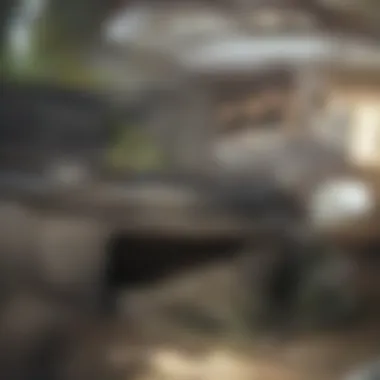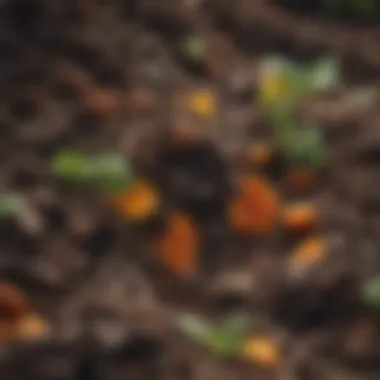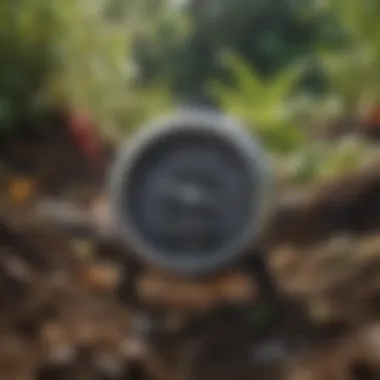Comprehensive Guide to Starting Home Composting


Intro
Composting at home is an effective way to manage organic waste. By converting food scraps and yard debris into nutrient-rich soil, individuals not only reduce waste but also contribute positively to the environment. This section outlines the primary aspects of home composting, setting the stage for a practical guide on how to start.
Understanding composting begins with its core components. Kitchen scraps such as fruit peels and coffee grounds, along with yard waste like leaves and grass clippings, play a crucial role in this process. Utilization of these materials provides benefits beyond waste reduction, as compost can improve soil structure and fertility.
In this comprehensive guide, we explore various composting methods suitable for home use. We will detail the ideal materials to include, the science that supports composting, and the potential challenges a gardener might face. Readers will find maintenance tips essential for successful composting. By unraveling these elements, individuals will learn how to transform their organic waste into valuable compost that enriches the soil in their gardens.
"Every time you compost, you are making a choice to embrace sustainability, one kitchen scrap at a time."
This article aims to equip readers with the knowledge they need to start composting, addressing all aspects from setup to finished product.
Preamble to Composting
Composting represents a significant step towards sustainable living. It serves as a practical method to recycle organic materials, reducing waste while providing nutrient-rich soil for gardening and landscaping. In contexts such as urbanization and landfills overflowing with waste, understanding composting becomes essential. This practice not only diverts waste from landfills but also contributes to a healthier ecosystem and encourages responsible waste management.
Definition of Composting
Composting is the natural process of decomposing organic matter. This process involves microorganisms breaking down materials like food scraps, yard waste, and other biodegradable products. When these materials break down, they transform into a dark, rich substance known as compost. To put simply, composting is an effective way to recycle organic waste into something valuable for plants and soil.
Benefits of Composting at Home
Home composting brings several benefits:
- Waste Reduction: A considerable percentage of waste generated in homes comprises organic material. Composting significantly decreases the amount of waste sent to landfills.
- Enhanced Soil Health: The finished compost improves soil structure, enhances water retention, and provides essential nutrients that foster plant growth.
- Cost-Effective: By producing your own compost, you can save money on store-bought fertilizers and soil amendments.
- Environmental Impact: Composting reduces greenhouse gas emissions from landfills and lowers the need for chemical fertilizers.
Adopting composting is an investment not only for the environment but also for improving home gardens. This foundational knowledge of composting ensures that readers can appreciate the subsequent discussions surrounding the composting process.
Understanding the Composting Process
Understanding the composting process is crucial for anyone looking to start a sustainable waste management system at home. Composting transforms organic materials, such as food scraps and yard waste, into nutrient-rich compost. This process not only reduces landfill waste but also enhances soil health. Knowing how composting works allows you to optimize your efforts and make informed decisions about materials and techniques.
Through this section, we will explore the science of composting, the role of microorganisms, and the factors that influence the efficiency and quality of the composting process. This foundational knowledge is essential for successfully starting your own compost at home.
The Science Behind Composting
Composting is a natural biological process where microorganisms break down organic matter. This process requires the right conditions and materials to occur efficiently. The main goal of composting is to create a balanced environment for these microorganisms to thrive.
The biochemical breakdown of organic matter occurs in phases. Initially, the decomposition phase focuses on breaking down complex materials into simpler compounds. The stabilization phase follows, where the remaining organic matter is further decomposed into stable, rich compost. Understanding these phases helps in managing the compost effectively, ensuring you achieve the desired results.
Microorganisms and Their Role
Microorganisms are the heart of the composting process. They include bacteria, fungi, and other decomposers. Each type plays a specific role in breaking down different materials. For instance, bacteria tend to work quickly on green materials, while fungi excel in decomposing tougher brown materials.
These microorganisms require a suitable environment. Essential elements such as temperature, moisture, and oxygen levels play a significant role in their activity. Without the right balance, the microorganisms may not thrive, and the composting process can slow down or even halt.
Factors Affecting Composting
Several key factors influence the composting process:
- Temperature
- Moisture
- Oxygen
- Carbon to Nitrogen Ratio
Temperature
Temperature directly affects the rate of decomposition. In general, a compost pile should reach temperatures between 130°F to 160°F. This heat results from microbial activity, which helps to break down materials faster. High temperatures also help in pathogen reduction and seed viability destruction.


A well-managed compost pile will fluctuate in temperature. If it becomes too hot, it may sterilize beneficial microorganisms, while if it cools down too much, microbial activity slows, reducing compost quality. Thus, monitoring temperature is a beneficial practice for maintaining a healthy compost system.
Moisture
Moisture content in the compost pile is crucial for microbial activity. Ideally, the compost should be as damp as a wrung-out sponge. Too much moisture can lead to anaerobic conditions, causing foul odors and slow decomposition. On the other hand, too little moisture will inhibit microbial growth and slow the composting process.
Regularly checking for moisture ensures optimization. When the pile feels too dry, watering it lightly or adding wet materials can help maintain the balance. Keeping moisture at the right level is essential for successful composting.
Oxygen
Oxygen is vital for aerobic decomposition, which is the preferred method in composting. Aerobic bacteria require oxygen to thrive and efficiently break down organic materials. A lack of oxygen can lead to anaerobic conditions, which produce unpleasant odors and slow the composting process.
Turning the compost pile occasionally helps aerate and infuse oxygen into the materials. Ensuring good aeration is therefore essential for maintaining healthy microbial activity.
Carbon to Nitrogen Ratio
The carbon to nitrogen ratio (C:N ratio) is a critical aspect of successful composting. A ratio of 30:1 is often cited as ideal. Carbon-rich materials, known as browns, include dry leaves and straw, while nitrogen-rich materials, known as greens, include kitchen scraps and grass clippings.
Balancing this ratio keeps microorganisms well-fed, promoting efficient decomposition. An imbalance may lead to slow composting or undesirable odors. Therefore, understanding and managing the C:N ratio enhances the quality of your compost.
Proper attention to these factors not only improves the speed of composting but also enhances the nutritional quality of the end product.
Choosing a Composting Method
Selecting a composting method is a critical step in establishing your home compost system. The method you choose can significantly impact the efficiency of the composting process, as well as the amount of effort required from you. Featuring diverse routes to transforming organic matter into nutrient-rich compost, understanding the various methods helps you align your composting practices with your lifestyle, available space, and the types of materials you plan to compost.
Different methods have different space requirements, management levels, and timelines for compost maturation. This section will explore four distinct types of composting methods—each with unique benefits and considerations.
Traditional Compost Bin
The traditional compost bin is a widely recognized method of composting. It usually consists of a wooden or plastic structure that holds organic materials while allowing for aeration and moisture retention. One of the main benefits of this method is that it allows for a relatively large volume of waste to be processed at one time.
You can either purchase a ready-made compost bin or construct your own using pallets, wire mesh, or other materials. Factors such as ease of access, size, and placement are essential to consider when setting up a traditional compost bin.
Keep in mind that adequate aeration is needed to speed up the breakdown of organic material. This often means turning the compost regularly to introduce oxygen. Traditional composting works well for those with outdoor space and a moderate amount of organic waste.
Vermicomposting
Vermicomposting is another effective method, especially for people living in smaller spaces, such as apartments. This method utilizes worms, particularly red wiggler worms, to break down kitchen scraps into compost. The worms process organic waste and produce high-quality compost known as worm castings.
One attractive aspect of vermicomposting is its compact design. A worm bin can fit under a kitchen sink or in a closet, making it highly accessible. Furthermore, the process produces less odor compared to traditional methods, as worms efficiently process food waste.
Despite its benefits, vermicomposting requires careful management. You must ensure that the worms have adequate moisture and proper food ratios to maintain a healthy ecosystem. It also involves some knowledge about worm care.
Bokashi System
The Bokashi system is a unique fermentation-based composting method that allows you to compost food waste, including meat and dairy, which are typically avoided in traditional composting. This method uses anaerobic fermentation facilitated by Bokashi bran, which contains beneficial microorganisms.
The setup for this system involves a sealed bucket where food scraps are layered with Bokashi bran. The fermentation process typically takes about two weeks, after which the pre-compost can be buried in the soil or added to a traditional compost bin.
One primary advantage of the Bokashi system is its speed. Waste decomposes in a short time, and it can handle a variety of materials. However, it does require an initial investment in Bokashi supplies and may have a learning curve for newcomers.
Tumbler Composters
Tumbler composters are popular among those who prefer a more hands-off approach to composting. These sealed bins rotate to easily mix the compost without the need for manual turning. This facilitates aeration and speeds up the decomposition process.
Available in various sizes, tumbler composters can fit into smaller gardens or patios. Their construction often helps control odor and pests better than traditional bins. However, one should consider their cost and some maintenance requirements, such as ensuring the right balance between green and brown materials.


Essential Materials for Composting
Understanding the essential materials for composting is crucial for anyone looking to start their composting journey. The right mix of materials not only fosters an effective composting process but also ensures the resulting compost is rich in nutrients. Getting these materials in balance can significantly affect the rate of decomposition and the overall quality of your compost.
Green Materials
Green materials, also called nitrogen-rich materials, are key components in composting. They are typically moist and rich in proteins. Examples of green materials include:
- Vegetable scraps
- Fruit scraps
- Grass clippings
- Coffee grounds
- Manure from herbivores
The importance of green materials lies in their ability to provide the nitrogen necessary for the microorganisms that decompose organic matter. A healthy ratio of green materials enhances the heating of the compost pile, leading to faster decomposition. It is essential to not overload the compost with greens, as excessive nitrogen can create a rather unpleasant odor.
Brown Materials
Brown materials are carbon-rich components that also play a vital role in the composting process. Items like dried leaves, straw, cardboard, and small branches fall into this category. They are often dry and provide the crisp texture that aids aeration within the compost pile. The role of brown materials is to supply carbon that balances with nitrogen from green materials to create a healthy microbial environment. Here are some common examples of brown materials:
- Dried leaves
- Wood chips
- Paper products (non-inked)
- Sawdust
- Hay
Maintaining a balance between brown and green materials is essential for optimal decomposition. The commonly recommended ratio is about 30 parts carbon to 1 part nitrogen. This balance avoids issues like a too-wet pile or one that is too dry, both of which can hinder decomposition.
Avoiding Contaminants
Avoiding contaminants is crucial for successful home composting. Using the wrong materials can not only complicate the composting process but also produce harmful byproducts in the final compost. Certain contaminants should be strictly avoided:
- Meat and dairy products can attract pests and lead to odors.
- Oily substances like cooking oils can impede decomposition.
- Treated wood, as it may contain chemicals that can harm soil health.
- Diseased plant material can introduce pathogens into the compost.
Focusing on the right materials while avoiding contaminants ensures that the compost produced is not just safe but also enhances the soil without imparting any harmful chemicals. Paying close attention to these essential aspects of composting creates a strong foundation for a sustainable home gardening practice.
Setting Up Your Compost System
Setting up a compost system is a crucial step in making compost at home. The process does not only involve choosing the right bin or spot; it is also about optimizing conditions for effective decomposition. Having a well-designed system accelerates the composting process and ensures that the resulting compost is nutrient-rich and beneficial for your garden.
Choosing the Right Location
The location of your compost system significantly influences its performance. Ideally, you should place your compost bin in a well-draining area that receives a good amount of sunlight. This warmth will facilitate microbial activity, essential for breaking down organic materials. Consider also the proximity to your kitchen and garden. An easily accessible compost bin means that you are more likely to add materials consistently. Avoid damp spots where water accumulates, as these can lead to odor problems and create an inhospitable environment for the microorganisms involved in composting.
Building or Buying a Compost Bin
Creating a compost bin can be as simple or elaborate as you choose. If you prefer a DIY approach, you might use materials like wooden pallets, wire mesh, or even repurposed plastic containers. The bin should allow for adequate airflow while being enclosed enough to maintain heat and moisture levels. Alternatively, many people opt to purchase ready-made compost bins. Options like the Envirocycle Composting Tumbler or The Barrel Composter are efficient and user-friendly. When selecting a bin, ensure it is durable and suits your yard's space and design. Consider features like easy access for turning or adding materials.
Layering Techniques
Layering is an essential technique in building an effective compost pile. Proper layering of materials enhances airflow and moisture retention, both crucial for the composting process. Here are key points to follow:
- Start with a base layer of coarse brown materials, such as twigs or straw, to promote good aeration.
- Alternate layers of green (nitrogen-rich) and brown (carbon-rich) materials. Follow the 3:1 ratio, using three parts brown to one part green. This balance helps achieve optimal decomposition.
- Ensure to break down larger pieces of materials into smaller chunks to speed up decomposition.
- Finally, keep the pile moist, but not waterlogged. Adding water occasionally helps maintain the right moisture level.
Effective layering maximizes compost production efficiency and minimizes odors.
Understanding these elements in setting up your compost system contributes significantly to the whole process. By focusing on location, selecting the right bin, and mastering layering techniques, you lay a strong foundation for your composting journey.
Maintaining Your Compost
Maintaining your compost is vital for ensuring a successful and productive composting experience at home. A well-maintained compost system promotes the breakdown of organic materials into nutrient-rich compost. Neglecting maintenance can lead to various issues and diminish the effectiveness of your compost.
Turning the Compost
Turning the compost is an essential practice that aerates the pile. It introduces oxygen, which is necessary for the microorganisms that decompose the material. Regular turning, usually every few weeks, enables a quicker breakdown of organic matter. By mixing different layers, you also distribute moisture and heat evenly throughout the pile. This helps in achieving a more uniform composting process, yielding better quality compost.


Monitoring Moisture Levels
Moisture is a critical component in the composting process. Maintaining the right moisture level ensures optimal conditions for microbial activity. The ideal moisture content is often compared to that of a damp sponge. If your compost is too wet, it may become anaerobic. This can slow down decomposition and produce unpleasant odors. Conversely, if it is too dry, the microorganisms may become inactive, leading to stagnation. Regularly checking the moisture and adjusting by adding water or dry materials is crucial for healthy compost.
Recognizing Signs of Problems
Problems in composting can sometimes manifest as noticeable signs. Early recognition of these issues can save your compost from failing.
Odor Issues
Odor issues can indicate problems in your compost pile. A strong, rotten smell often suggests that the compost is too wet or lacking sufficient oxygen. This situation occurs when anaerobic conditions prevail, which slows down decomposition. Addressing odor issues typically involves turning the compost to aerate it better and adding dry materials to balance moisture. Fixing these issues not only improves the health of your compost but also ensures a more pleasant experience around your composting area.
Non-Decomposing Materials
Non-decomposing materials indicate that something is not quite right in your composting system. These materials might include large sticks, tough plant stems, or items that aren’t suitable for composting, such as certain types of plastic. Their presence can signal an imbalance in carbon-to-nitrogen ratios or insufficient moisture and aeration. Removing these materials can facilitate a more efficient breakdown process. Understanding what goes into your compost can prevent future complications and enhance the overall quality of the final product.
Proper maintenance is the key to a fruitful composting journey. By regularly turning the pile, monitoring moisture, and recognizing signs of problems, you set yourself up for success.
Harvesting and Using Compost
Harvesting and using compost is a crucial phase in the composting journey. It signifies the transformation of organic waste into a valuable resource. Properly used, this nutrient-rich compost can significantly enhance soil health and promote plant growth. Understanding how to identify when compost is ready and the best application methods can greatly improve your gardening success.
Identifying Ready Compost
Determining when your compost is ready for use is important. Ready compost has a dark, rich color and crumbly texture. The smell should be earthy, without any pungent odor. If it still has recognizable organic materials, it needs more time to decompose.
A few key signs can help you identify ready compost:
- Temperature: The compost pile should be cooler than it was during active decomposition.
- Appearance: Compost will be dark and have a soil-like structure. You should not see large pieces of food or plant matter.
- Smell: A pleasant earthy smell indicates it is ready. A foul odor suggests it may not be fully decomposed.
"Good compost can improve moisture retention and provide essential nutrients to plants."
Application Methods for Garden Use
There are various ways to apply compost in your garden. Each method has its benefits, so consider your specific gardening needs:
- Top Dressing: Spread a layer of compost on the soil surface around plants. This method enriches the soil as it gradually integrates with it.
- Soil Amendment: Mix compost into the soil before planting. This technique improves soil structure and nutrient levels.
- Mulching: Using compost as mulch helps retain moisture and suppress weeds.
When using compost, remember to incorporate it into your planting routines during optimal seasons, ensuring your plants receive the benefits right when they need them. Monitoring how plants respond can offer insights for future compost applications.
Culmination and Further Considerations
In summation, establishing a home compost system serves as a sustainable method to manage organic waste, contributing significantly to both household and environmental health. This article delineates the essential components and thoughtful considerations necessary for a productive composting endeavor. Understanding each segment of the composting process aids in developing a fruitful system that not only enriches soil but also reduces landfill contributions.
The benefits of home composting extend beyond just waste management. Home composting is a practical solution for enhancing soil quality, promoting healthier plants, and fostering biodiversity in your garden. Moreover, it nurtures a sense of environmental stewardship among individuals and families. Being aware of the entire process ensures that composting can be an enjoyable activity rather than a chore.
"Effective composting is not solely about decomposition; it's about creating a cycle of sustainability in your gardening practices."
Additionally, as one becomes more adept at composting, it opens up opportunities to explore advanced composting techniques that can further enhance results. Whether it is through vermicomposting or implementing a Bokashi system, each method brings unique advantages suitable for different lifestyles and spaces.
Recap of Key Points
- Composting is beneficial: It helps in managing organic waste while improving soil health.
- Understanding the process: Gaining knowledge about how composting works, including microbial roles and necessary materials, is essential.
- Different methods exist: Various composting methods cater to specific needs, such as limited space or faster decomposition.
- Maintenance is key: Active management of moisture, temperature, and aeration ensures effective composting.
- Harvest and utilize: Knowing how to identify ready compost aids in successful application to gardens.
Exploring Advanced Composting Techniques
For those looking to deepen their composting journey, several advanced techniques provide enriching alternatives. Vermicomposting utilizes red wigglers to break down food scraps, resulting in nutrient-rich worm castings. This method is particularly useful for urban dwellers with limited outdoor space, as it can be done indoors.
The Bokashi system offers another innovative approach. This fermentation method employs effective microorganisms to break down organic matter, including cooked foods and dairy, which are usually not suitable for traditional compost. This method primarily requires a Bokashi bin and an appropriate composting mix, subsequently transferring it to the soil or garden for enhanced fertility.
Tumbler composters facilitate faster decomposition through efficient, mechanical aeration. While traditional bins require manual mixing, tumblers simplify this process, allowing users to spin or turn the compost with ease, yielding faster results.
Each of these methods can be explored based on personal interest, available space, and desired outcomes. Adopted wisely, these advanced techniques can significantly enhance the effectiveness of your composting efforts.



